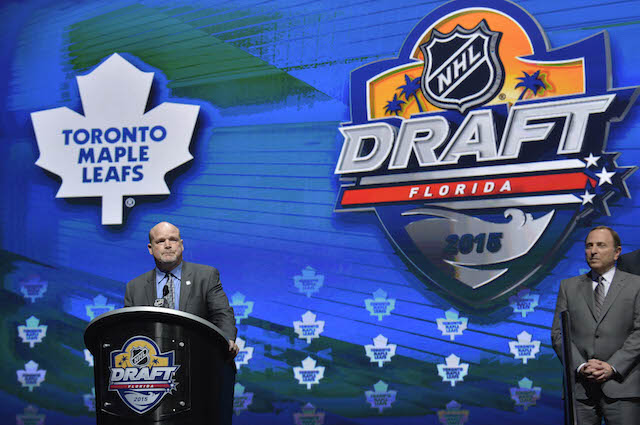Even though their team is on track to finish with one of the worst records in the NHL this season, you have to give the Toronto Maple Leafs front office credit. They have a very clear long-term plan in place, and they are going to great lengths to stick with it.
The NHL roster as it stands right now is bad. It is perhaps the worst one in the NHL and with each trade that has already been made, and will be made between now and the Feb. 29 trade deadline, it is only going to continue to get worse as team president Brendan Shanahan and general manager Lou Lamoriello reduce the organization to a pile of rubble so they can rebuild it from the ground up.
Keep one thing in mind about this year's Maple Leafs team: It was never built to win, and it certainly wasn't meant to be a developmental, trial-by-fire year for their best prospects at the NHL level. (There was no sense wasting a year of their entry level contracts or getting them close to unrestricted free agency in what was going to be a lost season.)
There are only a handful of players (Morgan Reilly, and perhaps Jake Gardiner and Nazem Kadri) that will still be on this team for more than another year or two.
This season was all about building up the value of individual players that had little long-term use to them and using them to accumulate future assets.
Toronto has spent the past two years assembling a team of veteran players on one-or two-year deals whose value they can boost up before flipping for draft picks. None of these guys were meant to be anything more than short-term roster filler. So far, the plan has been playing out perfectly as the Leafs hoard as many draft picks as they can while squeezing as much value as they can out of players that the rest of the league pretty much tossed aside.
In 2015 the Maple Leafs had nine draft picks. Thanks to their trades this season, including the blockbuster Phil Kessel and Dion Phaneuf trades, as well as the smaller Shawn Matthias and Roman Polak/Nick Spaling deals, they already have 12 picks in 2016 and eight in 2017.
That is a total of 29 draft picks over a three year stretch. Those picks include four first rounders (one each in 2015 and 2017, and two in 2016) and six second-rounders (two in 2015, one in 2016 and three in 2017). And you can bet that more will be coming.
It all started with short-term contracts to veterans like Mike Santorelli, Shawn Matthias, Daniel Winnik, P.A. Parenteau, Brad Boyes, and trades for veterans like Michael Grabner, Polak and Spaling.
The Maple Leafs knew these guys weren't going to add up to a competitive team. They had to know that. But they knew individually they could all play well enough, especially if put into the right situations, so that other teams would have interest in them at the trade deadline for a playoff run and would be willing to pay high prices. And Toronto has been able to capitalize on that.
Last year they packaged Santorelli with veteran defenseman Cody Franson, two players that were set to be free agents, for Olli Jokinen, a prospect (Brendan Leipsic) and Nashville's first-round draft pick in 2015. Toronto then immediately turned around and flipped Jokinen for a 2016 sixth-round pick before trading down with Nashville's first-round pick two different times, ending up with the 34th, 61st and 68th picks in the draft. That meant when all was said and done Toronto is going to come away with five assets (the four picks plus the prospect Leipsic) for two players that were set to be free agents, one of which (Santorelli) they made almost no commitment to.
Along with that deal, they added two additional picks (and 2015 fourth-round pick and a 2016 second-round pick) from Pittsburgh for Daniel Winnik, a player they signed to a one-year deal around the same time as Santorelli. The second-round pick acquired in that deal went back to Pittsburgh in the Phil Kessel trade, but that trade also brought them another first-round pick in 2016 and the Penguins' 2014 first-round selection, forward Kasperi Kapenen.
They are pretty much using the free agent market to buy draft picks, and they are doing it again this season.
Matthias, Polak and Spaling have already been moved for three future draft picks (including two second-rounders) and they would seem almost certain to move Boyes, Parenteau and Michael Grabner over the next week. And if they can get multiple second-round picks for Polak and Spaling, there is no reason to think they can't get a similar return for better, more talented players like Boyes, Parenteau and Grabner.
All of these picks are going to give the Maple Leafs options.
They can keep trading them either to move down (which they did multiple times in 2015) to add even more picks, see who pans out and keep the prospects they like. They can use them as a means to move up in the draft for a better prospect. They can use them to acquire NHL players.
In the end, this is definitely not going to be a quick rebuild.
Even though there is some hope in the farm system with top prospects like William Nylander, Mitch Marner, Kapanen and what will almost definitely be a top-four pick in 2016 on the verge of making an impact in the NHL very soon, it's still going to depend on what the team is able to do with this collection of draft picks. The pressure is now on the scouting staff to identify the right players and the Leafs' coaches throughout the organization to bring them along.
Not all of the draft picks are going to succeed. But they are at least giving themselves a ton of opportunities to find useful players.
If nothing else, it's a huge change from the days of the Dave Nonis front office where the team made huge, long-term investments in free agents and routinely let good assets (Mikhail Grabovski, Clarke MacArthur, and Nikolai Kulemin) all get away for nothing.






















